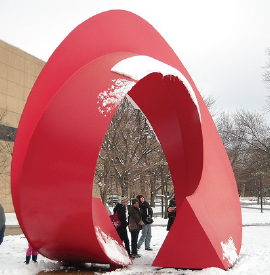Sculpture, Geometry and Computer Science
As part of Computer Science Education Week in December 2010, I worked with students from a
local public school to do some computer modeling of a sculpture found on the campus of IU-Bloomington.
This project was mentioned in the OSTP Blog of the White House (yes, the White House).
It was great fun and would not have been possible without the enthusiastic
encouragement of the artist, Charles Perry.
Sadly, Mr. Perry passed away a few short months afterward.
We went on to present this project at the SIAM CSE conference in 2011.
Presentation at SIAM CSE 2011 (Reno, NV)





Student Survey #1
http://www.surveymonkey.com/s/6GTGR9F
- simple questions about the sculpture itself
modeling-intro.pdf
link to page of earlier modeling effort using VisTrails
Installing the free, open source software
We will be using the Python programming language and the Visualization
Toolkit (VTK) library for the graphics. In addition, we'll use some other
Python-based tools.
Download them and install them in this order (these are all for the Windows operating system).
The installation process for the first 4 executables should be straightforward and consist
of clicking through 'Next's and 'Finish' on a dialog window. For the VTK compressed folder,
you will double click it and then click the 'Extract' at the top of the folder window.
- Python (version 2.6)
- numpy
- for fast numerics (not really needed yet, but could be useful later; but if your
installations take a long time, you can skip it)
- pyreadline - makes for a nicer IPython session
- IPython - an enhanced interactive Python shell
- VTK compressed folder (with Python classes)
- extract this compressed folder someplace easy, that you'll remember (e.g. for me: c:\users\randy\vtk)
Start -> Control Panel -> System -> Advanced system settings -> Environment Variables:
User variables (at top):
New: PATH c:\python26;c:\users\randy\vtk\bin
New: PYTHONPATH c:\users\randy\vtk\lib\site-packages
Using IPython
Start key (lower-left) -> All Programs -> IPython (folder) -> IPython
(right click and "Pin to Start Menu")
then just: Start key -> IPython
try tab-completion of commands
to quit: ctrl-z then Enter
Inside IPython, can use commands like:
pwd (print working directory/folder)
cd (change to a different directory/folder)
ls (list directory/folder contents)
import sys
print sys.path
--> [...,'c:\\users\\randy\\vtk\\lib\\site-packages', ...]
x = 13
x = x+1
print x
import math (import a Python module named 'math')
dir(math) (shows all functions and attributes in the math module)
print math.pi
print math.sin(math.pi/2)
run pythonScript
(e.g. 'run fruit', after downloading the fruit.py script below and having it in your working directory)
Python scripts
fruit.py - how to create a Class in Python
VTK-related scripts:
axes.py - display a 3D axes in VTK

- run this script from your IPython session with the command: run axes
- you can rotate the rendered geometry by holding/dragging your left mouse button in the window
c1.py - generate/display a circle of spherical "glyphs"
 c1b.py - generate/display a twisted, broken circle of glyphs
c1b.py - generate/display a twisted, broken circle of glyphs
 c1q.py - generate/display polygons (quadrilaterals) between 2 curves
c1q.py - generate/display polygons (quadrilaterals) between 2 curves

Aside: Geometry and the Imagination (Hilbert and Cohn-Vossen)
This book was co-authored by David Hilbert, probably the greatest mathematician who lived in the 20th
century.
Unfortunately, the Google books version of this book does not contain the preface, written by
Hilbert in Gottingen, Germany, dated June 1932. There, he states that this book is:
"a presentation of geometry in large brush-strokes, so to speak, and based on the
approach through visual intuition, should contribute to a more just appreciation of mathematics
by a wider range of people than just the specialists. For it is true, generally speaking, that
mathematics is not a popular subject, ... The reason for this is to be found in the common superstition
that mathematics is but a continuation, a further development, of the fine art of arithmetic, of
juggling with numbers. Our book aims to combat that superstition, by offering, instead of formulas,
figures that may be looked at and that may easily be supplemented by models which the reader
can construct. This book was written to bring about a greater enjoyment of mathematics ...
We want to take the reader on a leisurely walk, as it were, in the big garden that is geometry,
so that each may pick for himself a bouquet to his liking."
Google books link
page 6: involute
page 46: sphere packings
page 107: equilateral triangle and automorphism
page 191 (not in GBooks): catenoid and Monkey saddle
page 210 (not in GBooks): minimal surfaces; soap surfaces; helicoid
page 305 (not in GBooks): one-sided surfaces
This book presents "models" as line drawings and physical models. We will expand on that with
computer models.
Note: Even though Hilbert was a great mathematician, that's not to say he didn't
make mistakes ... (list his 3 predictions).
Future directions
create variations of the Indiana Arc
submit for stress analysis to the supercomputers in the IU Data Center
create an artistic animation video of the Arc (set to music?) and post on youtube
Email me with any questions you may have: heiland--at--indiana.edu or randy.heiland--at--gmail.com













